Day 1 of a two day Private Tour up on the North Norfolk coast today. It was mostly a nice, warm, sunny day, but there was some sea fret lingering offshore which was blown in on the moderate NE breeze, so it was a bit foggy on the coast for a couple of hours around the middle of the day.
We made our way west along the coast today – our first destination was at Titchwell. As we got out of the car, a tit flock was in the trees above us. We could see several Long-tailed Tits in the Sycamores, and hear a Coal Tit singing. There were also several Chiffchaffs and Chaffinches with them, picking around for insects amongst the leaves.
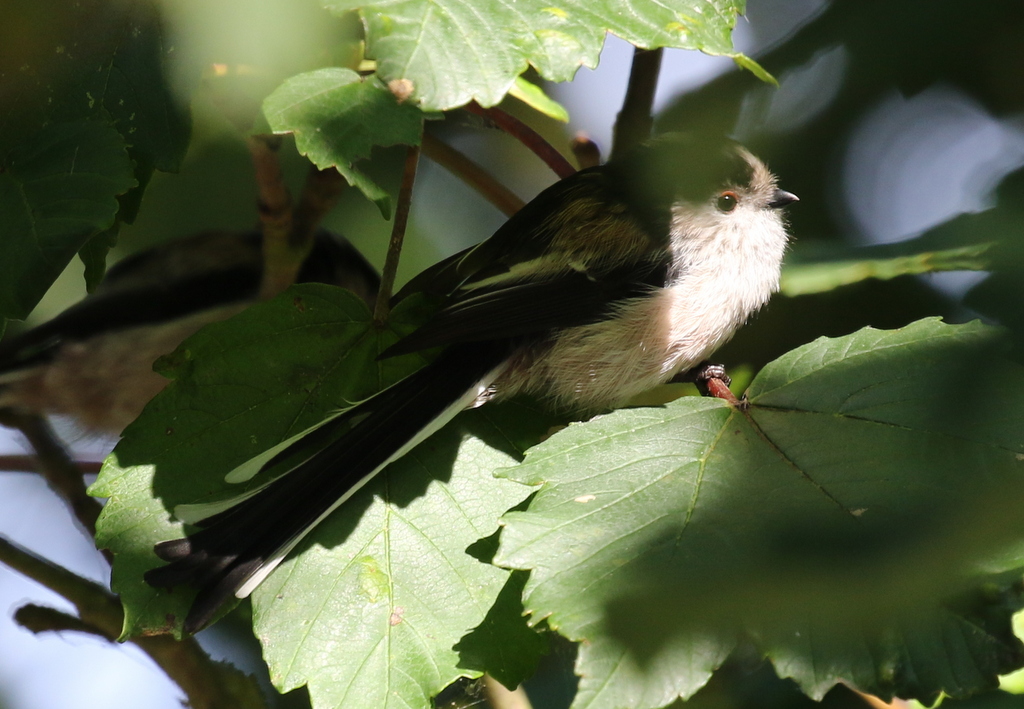
The overflow carpark can be a good place to look for warblers at this time of year, before it gets too busy. There were already several people walking round this morning, but we still managed to find lots of birds. We stopped by a quiet corner, and scanned the brambles, elders and hawthorns laden with berries.
A couple of Reed Warblers appeared first, one of them finding a branch in the morning sun where it stopped to preen. It is always odd to see them clambering round in bushes at this time of year. Several smart silvery grey Lesser Whitethroats clambered around after the berries – they are always much easier to see at this time of year. A rusty brown Common Whitethroat came out too, followed by several Blackcaps. There was a large flock of Goldfinches and Greenfinches up in the top of the trees, and a Song Thrush appeared briefly too.
That was a great selection of birds to start our visit here and so we headed out to the reserve. As we walked out along the main path, we could hear Bearded Tits pinging in the reeds but they were a long way out and hard to see. A couple of Marsh Harriers circled over the back of the reedbed.
There was nothing of note on the dried up grazing meadow pool, which is getting rather overgrown now, but as we scanned over the reeds a Sparrowhawk flew low towards us over the bare ground. It flushed several Woodpigeons, then landed briefly out of view behind the reeds at the front, before it was off again towards the trees.
The reedbed pool held a few Common Pochard and a pair of Gadwall. A Green Sandpiper flew round calling loudly, before dropping down behind the reeds, and a Common Snipe flew over too, its raspy call alerting us to its approach. A Bearded Tit zipped across over the reeds, too quick for everyone to get onto.
We stopped in at Island Hide first, to see what was on the Freshmarsh. There were lots of birds out here today – mostly ducks and waders. There has been a Red-necked Phalarope in residence for the last few days, a bird we particularly wanted to see. Scanning carefully, we found it right at back, swimming around amongst the ducks. We could see its distinctive shape, short sharp bill and white head and neck with black bandit mask.
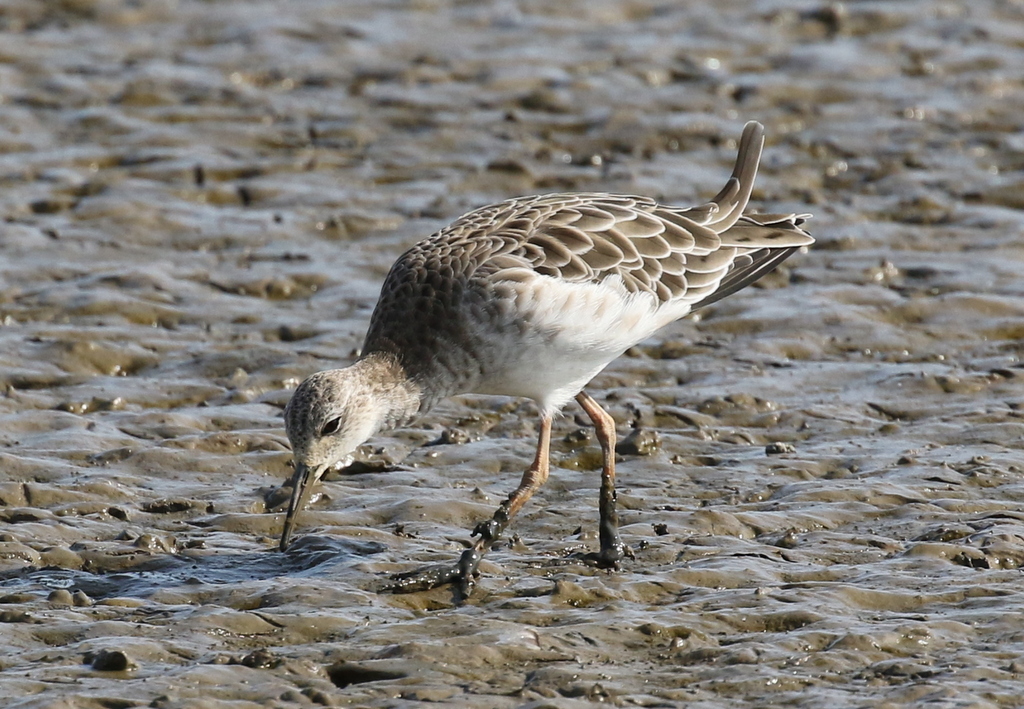
There was a great selection of other waders on here too today. The first thing we noticed on the mud in front of the hide were all the Ruff, the adults now mostly in their drab grey-brown and white non-breeding plumage. A huge mass of godwits spread across the middle of the scrape, a mixture of Black-tailed Godwits and Bar-tailed Godwits. The latter had probably come in from the beach to roost, ahead of the rising tide, and we could see several of them were still sporting the remnants of their rusty breeding plumage.
Scanning through all the godwits, we could see a few much smaller Knot and Dunlin mixed in with them. There was a single juvenile Curlew Sandpiper too. When it was asleep, its clean white belly and brighter supercilium set it apart from the Dunlin nearby. When it woke up, we could see its longer, more downcurved bill.
A single Spotted Redshank was lurking in the deeper water right at the back, against the reeds. We could hear a Greenshank calling and looked across the scrape to see three land briefly on the edge of one of the islands. There are still quiet a few Avocets here too, and a Ringed Plover appeared briefly on the mud. A large flock of Golden Plover circled over and dropped down onto the islands. Every so often, all the waders would take off and whirl round as a Marsh Harrier drifted high over the scrape.
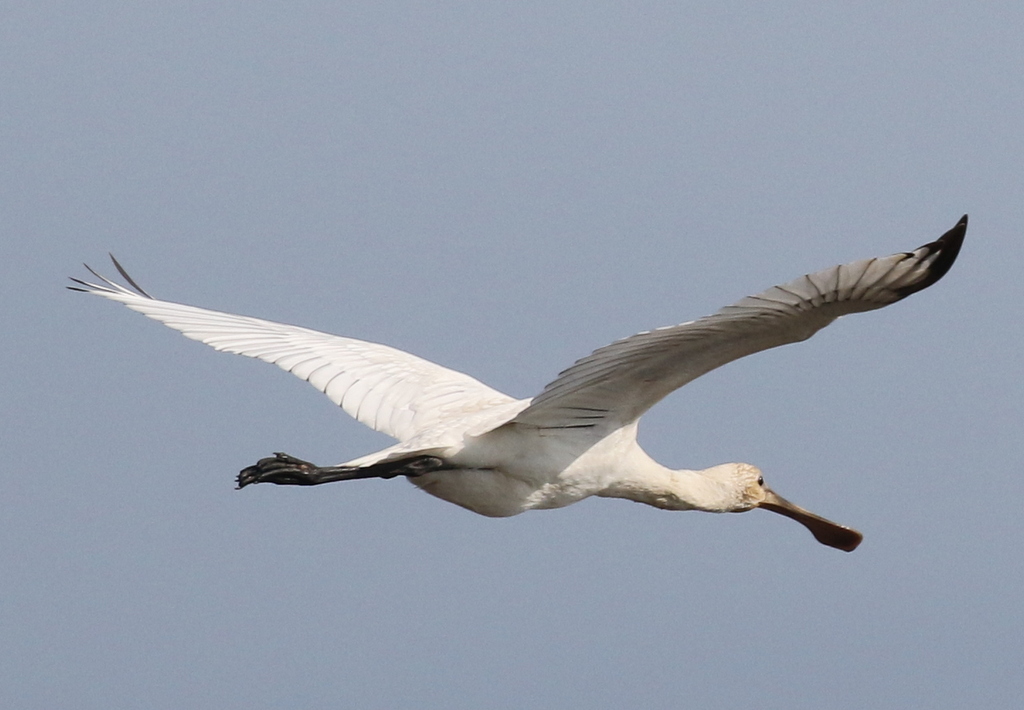
The tide was obviously rising now out on the saltmarsh, as the Spoonbills started to appear, flying in from where they had been feeding. First a pair landed out on the Freshmarsh, an adult pursued by its offspring, demanding to be fed – the ‘little beggar’. This was followed almost immediately by another big group of eighteen. Another loner arrived shortly afterwards, taking us to 21 Spoonbills in total. They landed out in the middle of the Freshmarsh at first, but were quickly spooked by a passing Marsh Harrier and disappeared round the back of Avocet Island out of view.
As we made our way round to Parrinder Hide next, we could already see patches of sea fret in the distance beyond. As we sat in the hide, the fog started to blow in over the Freshmarsh. It was rather eerie, looking at all the birds shrouded in fog.

Despite the fog, we could still see quite a few birds from the hide. Two Pink-footed Geese were feeding just in front with a single Greylag. The Pink-footed Geese are both birds which have been here all summer, unable to migrate back to Iceland for the summer due to broken wings.
A couple of Snipe were feeding on the edge of the fenced-off island, probing their beaks vigorously into the mud. A Common Sandpiper finished bathing in edge of water, and walked up onto the stony edge of the island to preen.
Given the fog, we were not sure whether or not it would be worth walking out to the beach. At least the fog did seem to be coming and going. As we looked out from the other side of Parrinder Hide, the visibility seemed to improve a bit. The tide was fairly high now, and much of the Volunteer Marsh was under water. We could see a couple of small groups of Curlew roosting in the taller vegetation and one Curlew feeding just below the hide. Several Common Redshanks and three Little Egrets were out on the mud.
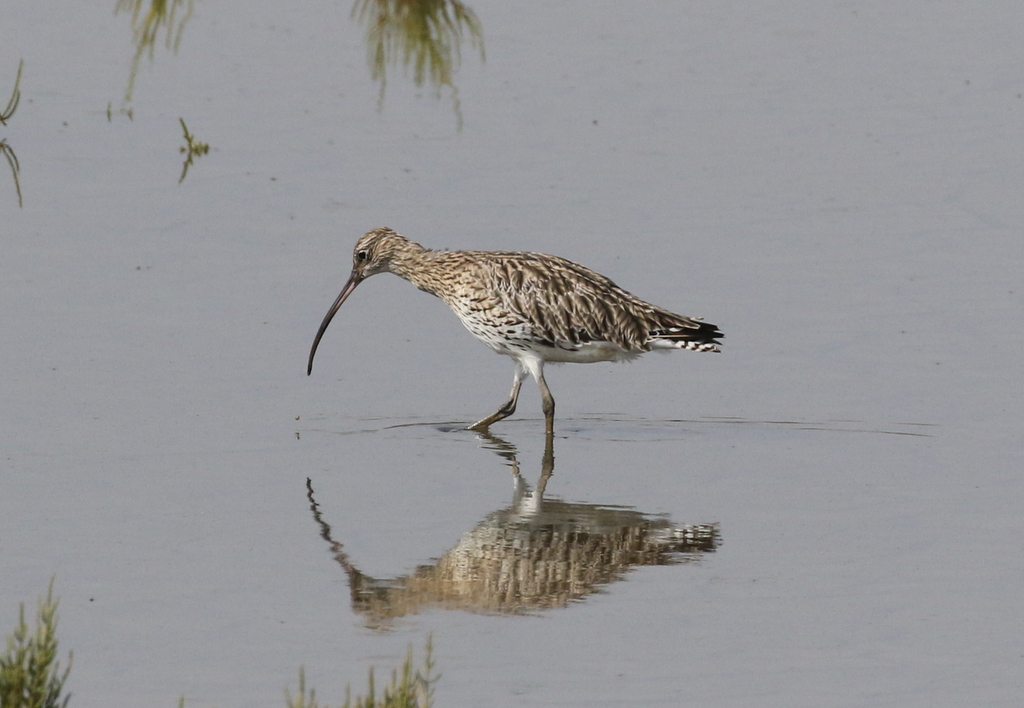
We decided to continue on, out to the Tidal Pools first. At the back of the pool just beyond the bank, we could see lots more Common Redshanks, with two Greenshanks asleep nearby. Further on, more waders were roosting on the larger island over high tide. We could see lots of Oystercatchers, and a long line of Turnstones, some still in the remains of their brighter summer plumage. There were several Grey Plover too, most of them still in breeding plumage too – we could see their black faces despite them being asleep and facing away from us, into the wind.
There were still wisps of fog blowing in, as we made it to the beach. We looked up to see a Grey Heron flying high in off the sea. It circled over the back of the beach, presumably a migrants coming in from the continent. There were a few Sandwich Terns feeding just offshore, and a little party of Sanderlings on the edge of the sea, with a Turnstone and a Dunlin for company.
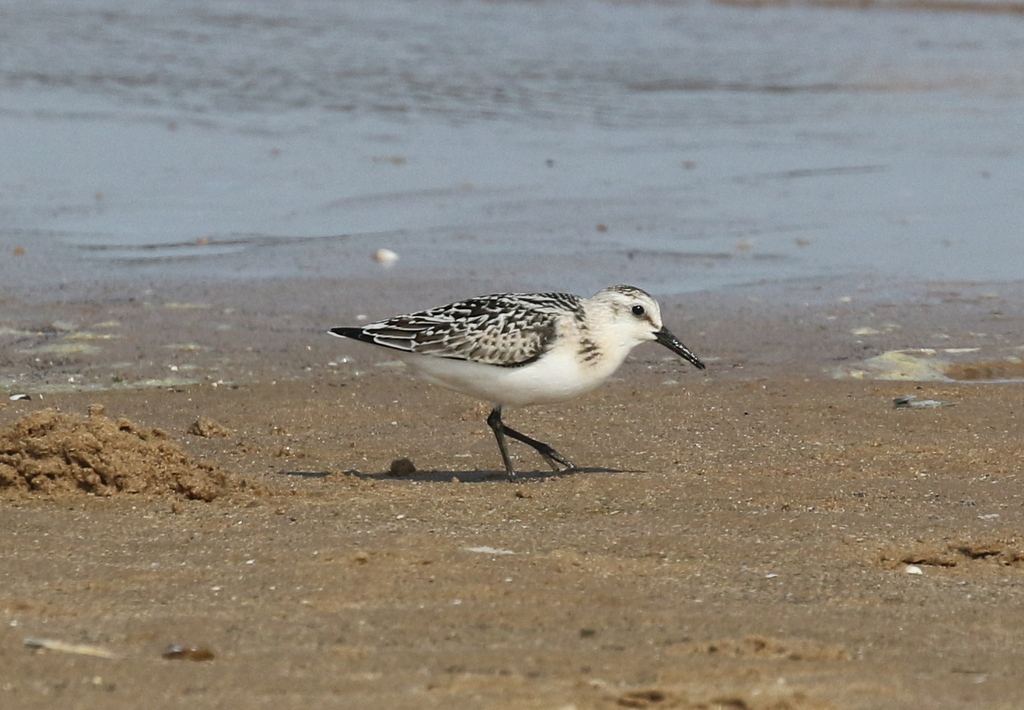
As we started to walk back, two juvenile Common Terns circled over the Tidal Pools. We stopped again at the Freshmarsh for a quick scan, as another small flock of Dunlin dropped in out on the mud. But we were then told that there were two Garganey and a Great White Egret round on Patsy’s Reedbed, so we decided to head round there quickly first, before lunch.
As we made our way round via Meadow Trail, we could hear a Cetti’s Warbler sub-singing in the trees by the dragonfly pool – good to hear, as we lost so many of them in the cold winter weather earlier in the year. Otherwise, the trees were quiet, so we made our way quickly round to Patsy’s.
When we arrived at Patsy’s, the first thing we saw was the Great White Egret. It was hard to miss, a large white bird as big as a heron with a long, dagger-shaped yellow bill! We had a good look at it through the scope, stalking slowly through the shallows at the back. It had earlier been seen on the saltmarsh at Thornham Point, and then flying off over towards Brancaster, so it had presumably come in to here to feed over high tide.
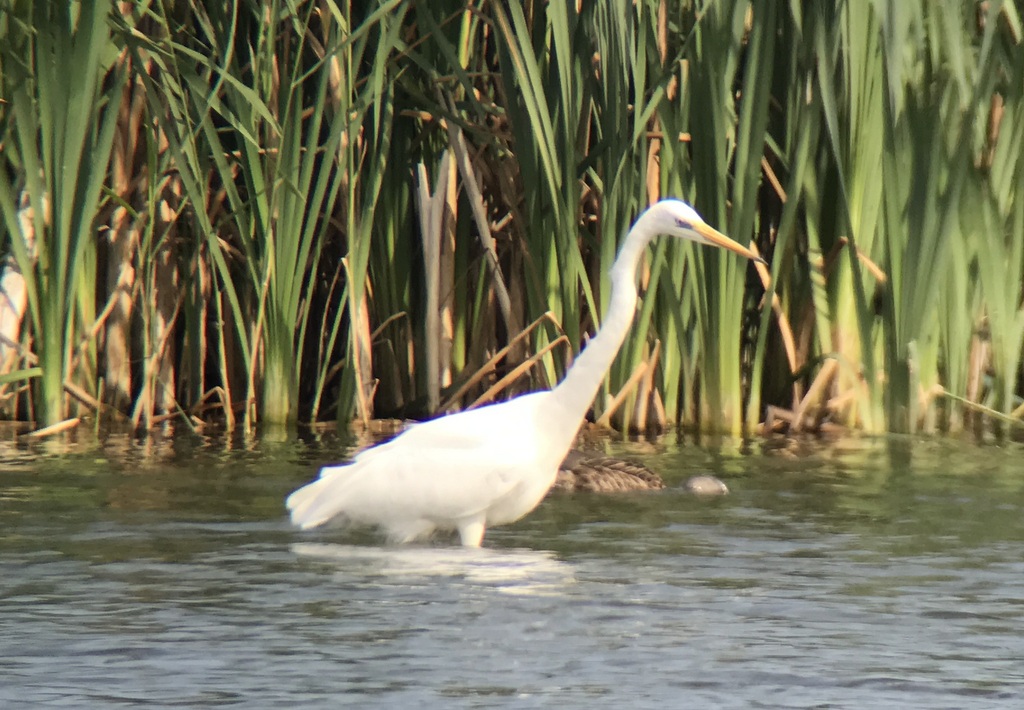
There was a great selection of ducks on Patsy’s too today. As well as the usual Mallard, Gadwall, Shoveler and Teal, there were a few Wigeon. One of the Garganey was busily upending at the back, but we occasionally got a look at its strongly marked face pattern. There were several Common Pochard and a single Tufted Duck too, and two female Red-crested Pochard eventually emerged from the reeds.
We could hear Bearded Tits calling periodically and eventually spotted a male working its way slowly round the base of the reeds along the back edge of the pool. We got it in the scope, and could see its powder blue/grey head and black moustaches.
Then it was time to head back to the picnic area for a late lunch. While we were eating, we heard news that a Pied Flycatcher had been seen over at Holme, so after lunch we decided to head over there to see if we could find any migrants.
There were several butterflies out on the seawall in the afternoon sunshine – Common Blue, Small Copper, Small Heath. A big group of Swallows were hawking for insects low over the saltmarsh beyond, feeding up before heading off south to Africa for the winter.
We headed round to check out the paddocks first, to see what we could find. A Chiffchaff calling loudly and incessantly from the pines by the first house was potentially a good sign, but after that it was quiet apart from lots of House Sparrows in the brambles.
A small dove flew across the paddocks behind us and we turned to see it was short-tailed and flashed a white belly as it banked. It was a Turtle Dove. It flew out across the saltmarsh and dropped down into the low dunes just behind the beach. A nice bonus!
A little further on, we heard Long-tailed Tits calling and found a flock feeding in some bushes by the path. As well as the Long-tailed Tits, there were Blue Tits and several warblers – at least three Lesser Whitethroats, two Common Whitethroats, a Blackcap and a few Chiffchaffs. As they disappeared out across the paddocks, we got a good look at the silvery grey Lesser Whitethroats in particular.
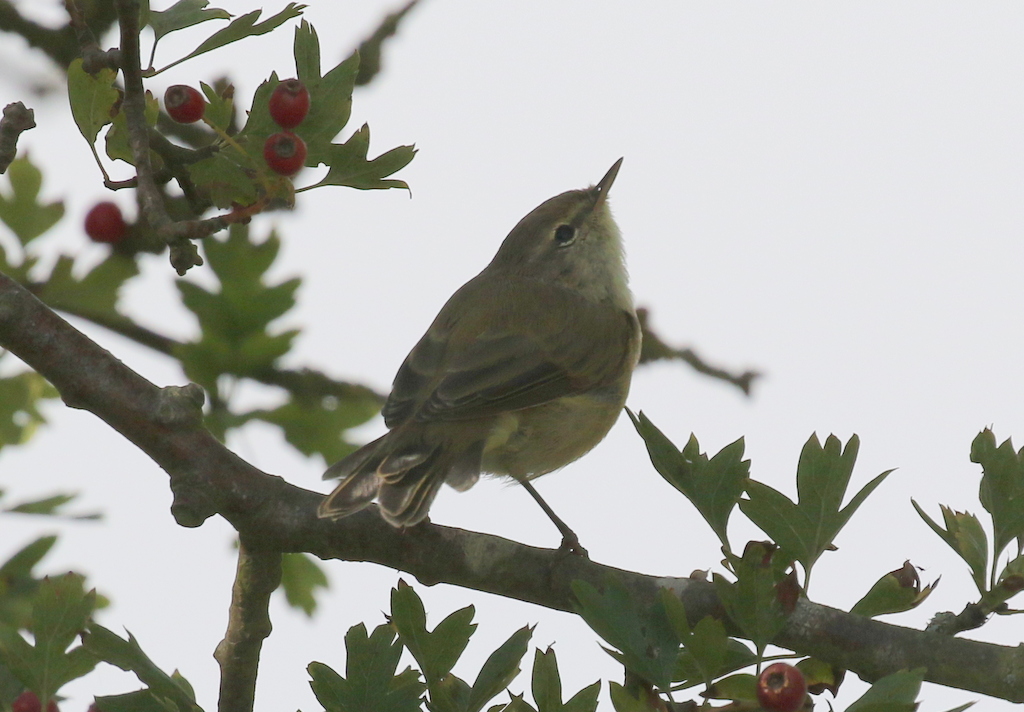
The Pied Flycatcher had been seen earlier round by the entrance track, so we headed over and checked out the trees. We found the same tit flock again, the other side of the paddocks, but there was no sign of anything else. Presumably the flycatcher was a fresh arrival and had moved on in search of somewhere better to feed.
We were then told there were some Whinchats in the dunes, so we continued along the coastal path towards the reserve. A Whimbrel flew past calling, high over the beach somewhere, but we couldn’t see it from where we were. Eight Spoonbills flew past too, easier to see than the Whimbrel, possibly birds from the flock we had seen earlier at Titchwell, now heading out to feed on the falling tide.

When we arrived in the dunes, there was no sign of the Whinchats at first – it seemed rather quiet. But searching carefully, we came across a couple of Common Whitethroats and then found three juvenile Stonechats. We figured the Whinchats must surely not be far away and, scanning the tops of the bushes, we found at least two perched up. We had a good look at them through the scope – buffier and more orangey than the darker, rusty Stonechats and with a much more obvious pale supercilium.
We might have set off into the dunes for a closer look, but with one of the group still recovering from a broken ankle, we decided to save our energy for tomorrow. Hopefully it will be another exciting day!
















